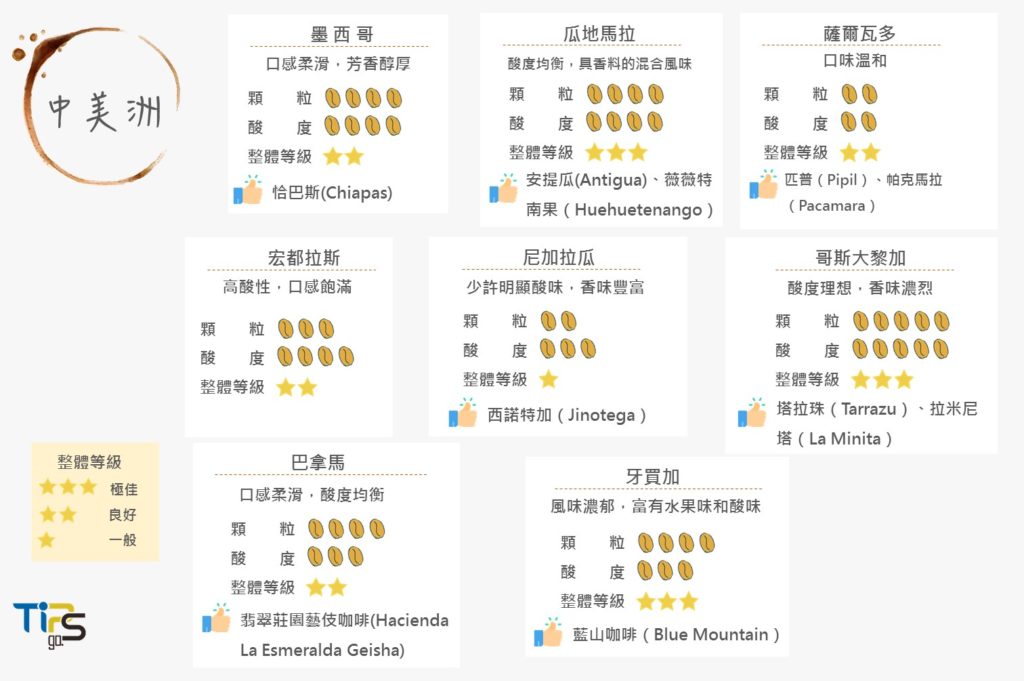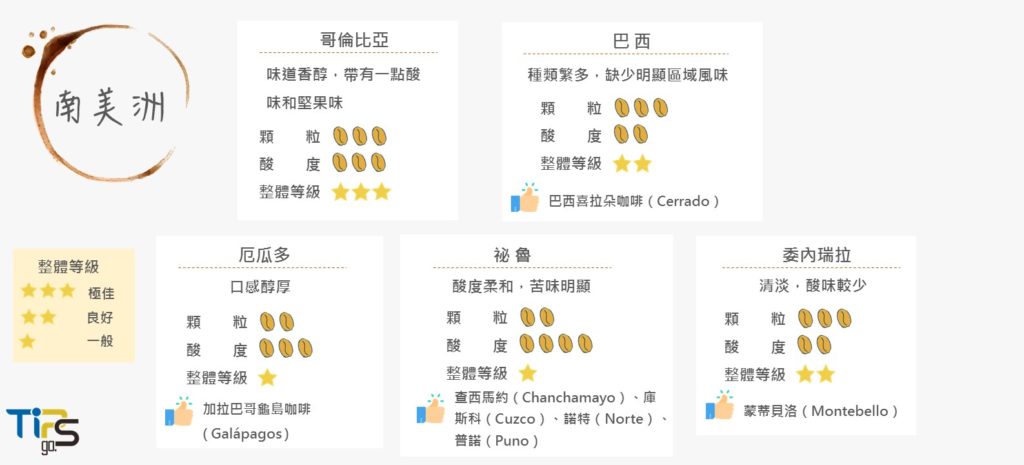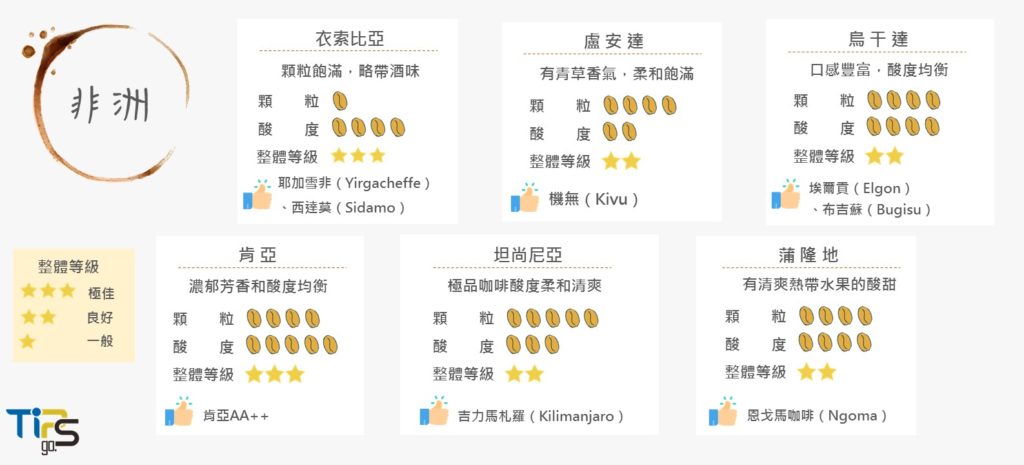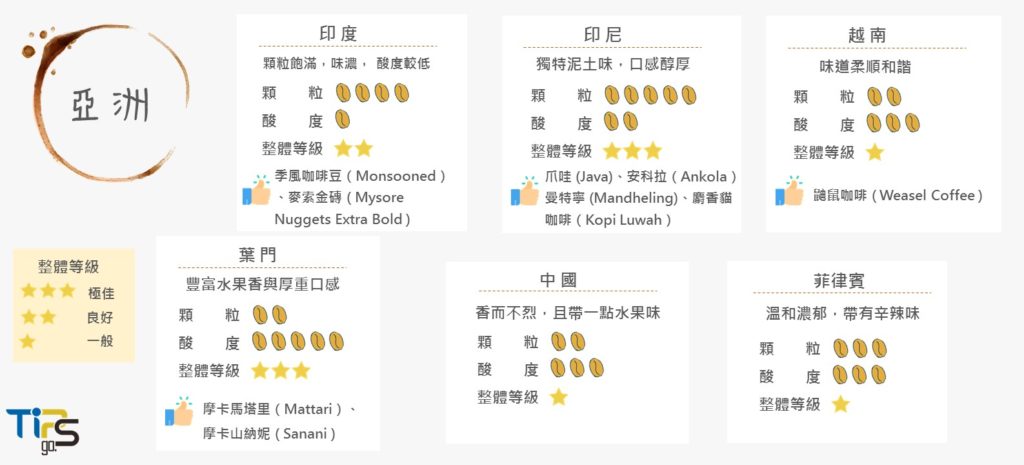Coffee beans vary from place to place. What flavor, what beans are good to drink and how to brew them?
Professional coffee knowledge exchange more coffee bean information please follow the coffee workshop (Wechat official account cafe_style)

Coffee is divided into three main categories of beans, Arabica beans, Roberta beans, and Liberian beans (there are very few on the market now)
There are many derivative varieties of Arabica and Robusta on the market.
Arabica derived varieties, such as: Tibika (Typica), bourbon (Bourbon), Rosa / geisha (Geisha), etc.
Robusta derived varieties, such as: Timor, SL28, SL34 and so on.
Add a little knowledge-what is single and mixed coffee beans
Single coffee (Single Origin)
The product is referred to as S.O, which emphasizes the concept of "Origin", that is, "source". The word "single product" is linked to the geographical location, which is used to accurately describe the origin or country of coffee, showing the unique flavor of that region or country. For example: Jamaica Blue Mountain, Hawaii Kona and so on.
Mixed coffee (Blend)
It refers to the blending of coffee beans from different producing areas to create a rich coffee flavor with different taste. For example: Italian coffee, Mamba (Manning + Brazil) and so on.
Main coffee producing areas
At present, coffee producing areas are mainly concentrated in Central and South America, Africa and Asia, because of different soils and climates, the beans produced have their own flavor.

The quality and flavor of coffee in Central America have a certain degree of stability, aroma, taste and taste are in the middle, the overall sense of balance is better.
☆ Blue Mountain Coffee, one of the three largest coffees in the world, is grown in the highlands of the Blue Mountains. The foggy environment can regulate the sunshine, making the density of raw beans stronger and the flavor rich. It is also because the output is very small and the price is high.
☆ Panamanian Jade Manor geisha coffee, at first, the tree was only used as a windbreak forest, but the coffee beans were surprisingly delicious. With its unique aroma and taste, it has repeatedly won the competition in recent years, setting a high bidding price of $170per pound.

Most of the coffee beans from South America are very sour and refreshing. Brazil is by far the largest exporter of coffee beans.

Coffee beans in Africa generally have acidity and aroma similar to that of fruit, with a rich taste. Ethiopia is considered to be the origin of coffee and the number one coffee exporter in the African region.

Asian coffee beans are often thought to have a thick taste, slightly lower aroma and acidity, and a spicy or herbal flavor.
☆ Coffee Coffee, a well-known rare coffee in Indonesia, is collected and processed from coffee fruits that have been eaten and excreted by civet. Indigestible coffee seeds, which are excreted intact, have a unique fragrance because they break down proteins after passing through the digestive system, but it also leads to controversy over animal cruelty.
Yemen Mochamatari, one of the three largest coffees in the world, is small and strong, with ripe fruit flavors (red grapes) and dark chocolate bitterness when ground, and a rich and mellow taste when tasted.
☆, Hawaiian Kona Coffee, one of the three largest coffees in the world, has citrus aroma and soft sour taste.
The characteristics of Taiwan coffee
That's right! Taiwan also produces coffee, which originated from 100 Arabica coffee trees introduced from Manila in 1884.
Taiwan coffee features: excellent aroma, unique micro-acid, mild and smooth taste after proper roasting.
Zoning characteristics
Western "mountain" coffee: with floral flavor, tea flavor, medium sour taste, this characteristic is similar to the alpine coffee in Central and South America. Including Dongli, Nantou, Yunlin, Chiayi, Tainan and other areas.
Southern "high prototype" coffee: floral and chocolate-flavored, not sour nor astringent, similar to coffee from the Isopia plateau, mainly from the Dawu Mountain system in Pingtung.
Eastern "coastal" coffee: with floral and spicy flavor, obvious sour taste, coffee characteristics are similar to island coffee producing areas.
International certification
American Fine Coffee Association (SCAA)
In 2009, Mr. Li Gaoming's Alishan tropical dance classic coffee won the 11th place in SCAA's "Coffee of the year". (83.5 points, only 12 per year, and only Asia was selected in that year)
In 2011, Mr. Guo Zhangsheng's Songyue Coffee Garden reached the SCAA final with 83.61 points.
In 2012, Mr. Li Gaoming's Alishan Tiebi card won the 12th place in SCAA with a score of 85.67.
American Society for Coffee quality (CQI)
In 2015, Xiangyang Coffee (86.08 points) and Baisheng Village Coffee Manor (84.92 points), also from Nantou Guolan Township, obtained quality grade certification (Q Certificate).
The general flavor of beans from different regions is as follows:
Brazil: most Robusta is produced, with a strong taste and a chocolate finish. ...
Central America, Colombia: light taste, good balance, low acidity and fruity finish. ...
Indonesia: earthy or smoky, bitter cocoa aftertaste, full-bodied.
Ethiopia: the origin of coffee is high in variety. ...
Kenya: it's thick and a little sour with tomatoes.
Hawaii: sweet, mild, mellow and supple.
Important Notice :
前街咖啡 FrontStreet Coffee has moved to new addredd:
FrontStreet Coffee Address: 315,Donghua East Road,GuangZhou
Tel:020 38364473
- Prev

Coffee with a huge weight loss effect? L-coffee? Efficacy and principle, advantages?
Professional coffee knowledge exchange More coffee bean information Please pay attention to coffee workshop (Weixin Official Accounts cafe_style) L-coffee ingredients 1. High-speed L-carnitine--a kind of amino acid nutrients, the main role is to burn fat effectively and promote energy metabolism. 2, Brazilian black coffee---not only can consume excess fat in the body, but also inhibit the absorption of new fat, control
- Next

Caffeine, wonderful and fragrant, has become the most popular addictive drink in the world. Why is it delicious?
Coffee workshop (Wechat official account cafe_style) Coffee is the world's most popular addiction ingredient caffeine wonderful and aromatic source, since it spread from Ethiopia in the 15th century, its spread has not stopped. In the Arab world, coffee is a substitute for wine, which leads to the rise of cafe culture.
Related
- Beginners will see the "Coffee pull flower" guide!
- What is the difference between ice blog purified milk and ordinary milk coffee?
- Why is the Philippines the largest producer of crops in Liberia?
- For coffee extraction, should the fine powder be retained?
- How does extracted espresso fill pressed powder? How much strength does it take to press the powder?
- How to make jasmine cold extract coffee? Is the jasmine + latte good?
- Will this little toy really make the coffee taste better? How does Lily Drip affect coffee extraction?
- Will the action of slapping the filter cup also affect coffee extraction?
- What's the difference between powder-to-water ratio and powder-to-liquid ratio?
- What is the Ethiopian local species? What does it have to do with Heirloom native species?

